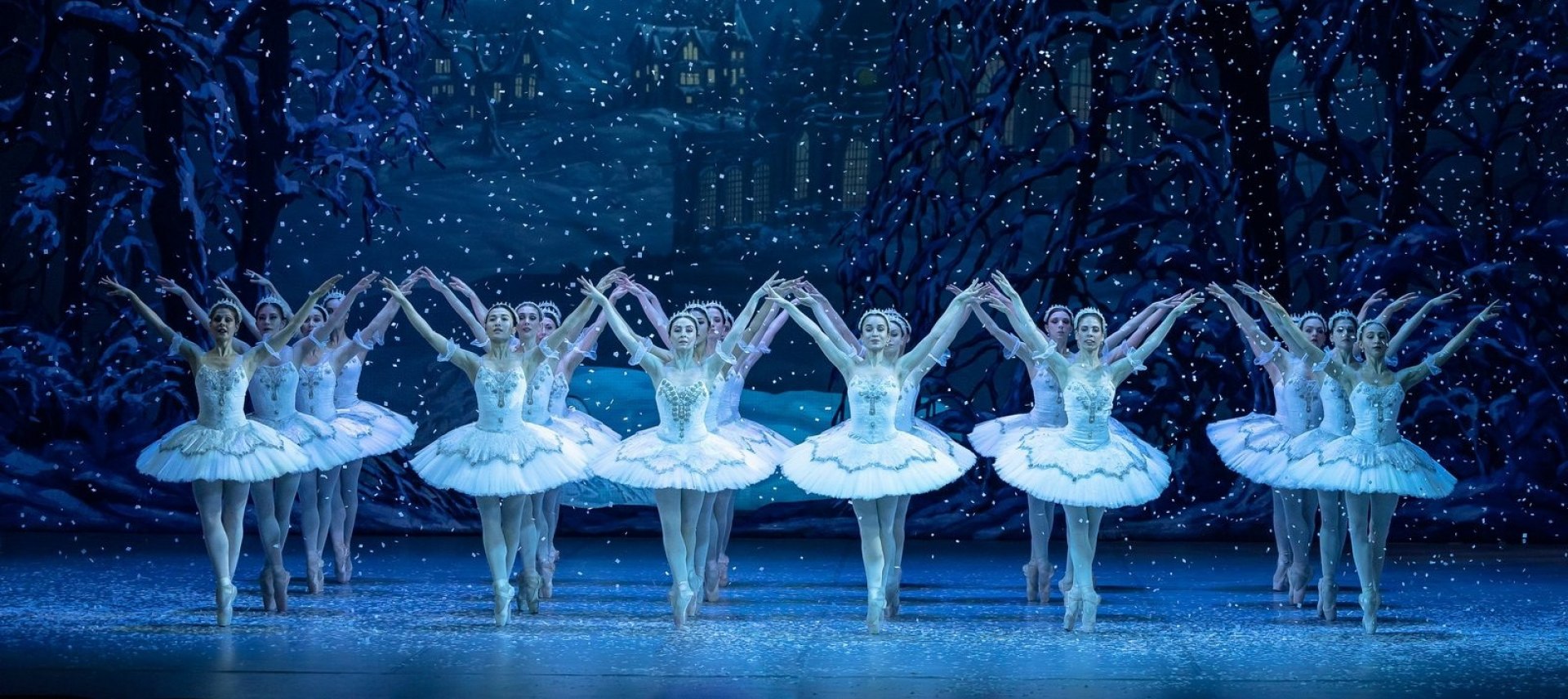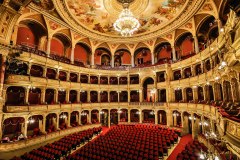The Nutcracker
Mo | Tu | We | Th | Fr | Sa | Su |
THE NUTCRACKER | Wayne Eagling – Tamás Solymosi / Pyotr Ilyich Tchaikovsky
Fairy-tale ballet in two acts
Performance length: 2 hours 30 minutes, with 1 intermission.
Tchaikovsky’s Nutcracker has for decades been an essential part of the world’s and the OPERA’s run-up to Christmas. In memory of the previous production that had been in the repertoire for more than half a century, for the Christmas of 2015, a newly buffed-up show was staged that follows classical ballet traditions while still conforming to the requirements of 21st century dance and set design. Partnering with Tamás Solymosi to choreograph a new fairy-tale ballet for the classical-music piece was a true Nutcracker specialist: the internationally renowned Wayne Eagling. It was the first time in the life of the Hungarian National Ballet that an artist of such worldwide stature had developed a choreography tailored specifically for it, with its unique characteristics in mind, in order to treat audiences to the ballet’s Christmas magic in a version that is even more full of spectacle and dance than the previous one.
Synopsis
Act I
By the chapel; at the Stahlbaum House
It is Christmas Eve, and as snow flurries fall, the smallest children of the Stahlbaum family, Marie, and her brother, Fritz head towards the chapel with their nanny while the rest of the family prepare for the great event. In front of the house there is an ice-skating rink and a vendor of roasted chestnuts. One after the other, the guests – including Uncle Drosselmeier and his nephew – arrive to celebrate together with the family.
The Christmas party
While the children wait in the antechamber to be allowed inside and see the Christmas tree, Drosselmeier performs a series of magic tricks to entertain them. The doors of the salon open up, and at Drosselmeier’s command the festivities begin. The guests gather around the beautifully decorated Christmas tree, where a great number of presents are waiting for the children. Marie’s uncle entertains the guests with a dance performance. The show is about the battle between the Nutcracker and the Mouse King, in which the Nutcracker is performed by Drosselmeier’s nephew and the Princess by Louise, Marie’s sister. Drosselmeier gives a nutcracker doll to Marie, who happily dances with her new favourite. Fritz thoughtlessly grabs the nutcracker doll from Marie, breaking it. Fortunately, Drosselmeier is able to fix the toy. The Christmas festivities close with everybody joining in a dance before the guests’ departure and the children going to bed.
Marie’s dream
Full of happiness and joy, Marie falls sound asleep, naturally with the nutcracker doll she has received beside her. The clock strikes midnight. As Marie dreams, everything seems to grow to an enormous size: the Christmas tree, the gifts, and the furniture. The dance show also comes to life. The Mouse King leads mice and rats in preparations to attack the house and Christmas tree. In her fright, Marie hopes that the Nutcracker will come to her aid. At the head of an army of lead soldiers who have come to life, the Nutcracker defeats the Mouse King.
Journey to the Land of Snow
The room and the house transform into a forest winter wonderland. Marie and Nutcracker delight in the Waltz of the Snowflakes together and then dance a lovely, lyrical duet to show their feelings for each other.
Act II
The journey
Marie and Nutcracker board Drosselmeier’s board to embark on a fantastic journey together. They are accompanied by Drosselmeier. The voyage to wonderland is a long one in which the young lovers find their path blocked by bats in a cave. Drosselmeier, however, disperses them with a single blow, and his magic kingdom opens up.
The Snow Crystal Palace
The inhabitants of the fairy-tale realm adoringly welcome Prince Nutcracker and his bride, Marie. A series of dance divertissements, in which the “residents” of the realm introduce themselves, ensues. A lively Spanish trio is followed by an Oriental snake-charming dance. Three Chinese dancers then entertain the guests with jumps and fast spins before the magnificent Russian dance commences. Next, is a pas de trois, a brilliant variation for “rococo” ballerinas, which leads, as the greetings conclude, to the climax of these divertissements: the Waltz of the Flowers. After the waltz comes the grand pas de deux between Princess Marie and Prince Nutcracker, a duet constructed in keeping with classical tradition as an adagio, two variations and a coda testifying to the fulfilment of their love. In the finale, they are joined by the entire corps de ballet and the enchantingly lovely inhabitants of the Snow Crystal Palace.
Marie’s room
On Christmas morning, Marie awakes from a wonderful dream. Racing into the room is Fritz, and they share the adventures they experienced in their dream. Marie herself is unable to say whether the Christmas magic was something she dreamed or actually experienced.
Program and cast
Conductor: Máté Hámori, Paul Marsovszky, Kálmán Szennai, Thomas Herzog, Sámuel Csaba Tóth
Princess Marie: Miyu Takamori, Tatyjana Melnyik, Maria Yakovleva, Lili Felméry, Soobin Lee, Ellina Pohodnih, Maria Beck, Yuki Wakabayashi, Ganna Muromtseva
Prince: Viachaslau Hnedchyk, Motomi Kiyota, Louis Scrivener, András Rónai, Gergő Ármin Balázsi, Taran Dumitru, Dmitry Timofeev, Boris Zhurilov
Drosselmeier: Vlagyiszlav Melnyik, Mikalai Radziush, Iurii Kekalo, Gaetano Cottonaro, Maxim Kovtun, Timofiy Bykovets
Mouse King/Mouse King doll: Léo Lecarpentier, Takaaki Okajima, Kóbor Demeter, Luca Massara, Vlagyiszlav Melnyik, Carlos Taravillo Mahillo, Mikalai Radziush, Iurii Kekalo
Princess doll/Louise: Yuliya Radziush, Théa Solomon, Yuki Wakabayashi, Nadezhda Sorokina, Stefanida Ovcharenko, Jingxuan Li
Choreographer: Wayne Eagling, Tamás Solymosi
Composer: Pyotr Ilyich Tchaikovsky
Set designer after Oláh Gusztáv: Beáta Vavrinecz
Costume designer: Nóra Rományi
Staging ballet master: Wayne Eagling
Company répétiteurs: Mária Aradi, Cristina Balaban, István Kohári, Albert Mirzoyan, Ildikó Pongor, Tamás Solymosi, György Szirb, Aliya Tanykpayeva
Répétiteur of the Hungarian National Ballet Institute: Olga Chernakova, Dmitrij Taraszovics Kirejko, Dénes Kovács, Dace Radina, Nataliia Yakushkina
Head of the Children's Chorus: Nikolett Hajzer
Hungarian State Opera
STANDING ROOM TICKETS - INFORMATION IN CASE OF A FULL HOUSE!
If all the seats are sold out for the selected time, but you still want to see the production on that day, 84 of the extremely affordable standing seats will be sold at the theatre, 2 hours before the start of the performance, with which you can visit the gallery on the 3rd floor. Tickets can be purchased at the ticket office of the Budapest Opera House. We would like to draw your attention to the fact that the stage can only be seen to a limited extent from the standing places and the side seats, but at the same time, following the performance is also supported by television broadcasting on the spot.
The Opera House is not only one of the most significant art relic of Budapest, but the symbol of the Hungarian operatic tradition of more than three hundred years as well. The long-awaited moment in Hungarian opera life arrived on September 27, 1884, when, in the presence of Franz Joseph I. the Opera House was opened amid great pomp and ceremony. The event, however, erupted into a small scandal - the curious crowd broke into the entrance hall and overran the security guards in order to catch a glimpse of the splendid Palace on Sugar út. Designed by Mikós Ybl, a major figure of 19th century Hungarian architecture, the construction lived up to the highest expectations. Ornamentation included paintings and sculptures by leading figures of Hungarian art of the time: Károly Lotz, Bertalan Székely, Mór Than and Alajos Stróbl. The great bronze chandelier from Mainz and the stage machinery moda by the Asphaleia company of Vienna were both considered as cutting-edge technology at that time.
Many important artists were guests here including Gustav Mahler, the composer who was director in Budapest from 1887 to 1891. He founded the international prestige of the institution, performing Wagner operas as well as Magcagni’ Cavalleria Rusticana. The Hungarian State Opera has always maintained high professional standards, inviting international stars like Renée Fleming, Cecilia Bartoli, Monserrat Caballé, Placido Domingo, Luciano Pavarotti, José Cura, Thomas Hampson and Juan Diego Flórez to perform on its stage. The Hungarian cast include outstanding and renowed artists like Éva Marton, Ilona Tokody, Andrea Rost, Dénes Gulyás, Attila Fekete and Gábor Bretz.

 EN
EN DE
DE IT
IT FR
FR ES
ES RU
RU JP
JP RO
RO
 Seating plan
Seating plan 